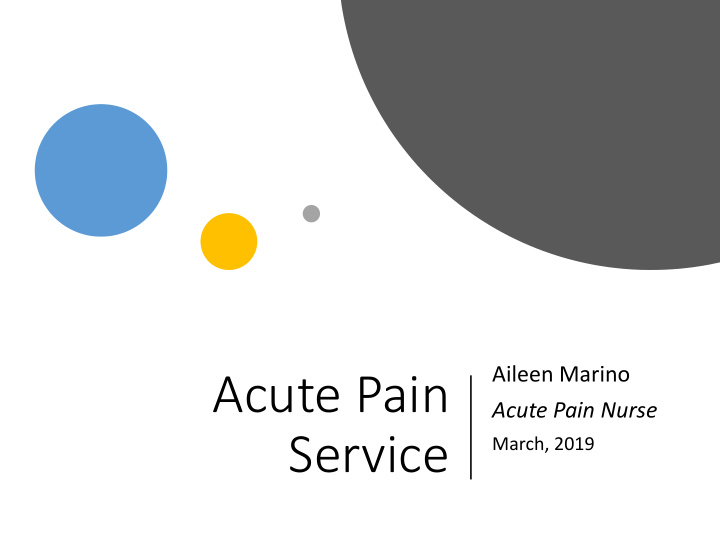



Aileen Marino Acute Pain Acute Pain Nurse Service March, 2019
New Service to LRH Introduced in 2017 Acute Pain Anaesthetic driven Service Acute pain focus Acute/ chronic pain
The role Target surgical patients/pre operative Post Op day 1-4 more if needed Anaesthetic referral / ward referral Pain round x2 daily Pain assessment: DB&C,N/V and Pain score N/V, paperwork
• Patient • Pre-admission • PACU Education • Staff • on pain round • in-services • Epidural workshop/assessments
Orthopedic General Surgeries that Thoracic require APS Gynecology Trauma
• GA • GA and nerve block • Intrathecal (spinal) local anaesthetic: Anaesthetic bupivacaine, heavy +/- fentanyl, intrathecal morphine, clonidine, types dexmetatomodine. • Epidural • Local anaesthesia and sedation • REDUCE PAIN IN THE LONG TERM
local anaesthetic infiltration at a nerve to cover a specific area of the body _ultrasound guided single shot +/- continuous infusion of LA Interscalene, supraclavicular Local anaesthetic Paravertebral block blocks TAPS Block Femoral, Adductor canal Rectus sheath, erector spinae plane, lumbar plexus
Paravertebral block Paravertebral block
• Oral analgesia Pain • Epidurals relieving • PCA • Narcotic infusion medicines • Local anaesthetic infusers set rate • L. A. Infusions adjustable & devices rate/volume.
Advantages of LA infusers Decreased Pain: decreased Early mobilisation incidence of chronic pain Less narcotics: Decreased risk of post opertive complications beneficial in the (DVT, Ilius, pressure areas, elderly constipation, chest infections)
Patient education Patient Assessment Your role: Th The Experts! Pain score documentation Pharmacological knowledge
Case study • 78.9 year old female • Dx with a sigmoid Carcinoma on colonoscopy • 160 cm - 53kg • PHx • Ist degree heart block( RBBB), Mild Aortic Stenosis - last ECHO 2016 • Palpitations • thyroidectomy • Medications • Atenolol 50 mg mane • Rosuvistatin 5mg Daily • Levothyroxine 50mcg Daily. • Fit and healthy, plays golf (carries her clubs!) • Last food 0700hrs 1/5/18 • Last fluid 0400hrs 2/5/18
Case study: DOS_ Lap assisted Rt hemicolectomy • GA, thoracic epidural, art line, Iv Hydration line IDC • Anaesthetic chart. • IV Abs prophylactically • IV fluid <5 ml/kg/hr + intraoperative loses • Art line to guide vasopressors • Maintained core temp • IV opioids avoided • NG removed prior to the end of the case
Case study: DOS_ Lap assisted Rt hemicolectomy • GA, thoracic epidural, art line, Iv Hydration line IDC • Anaesthetic chart. • IV Abs prophylactically • IV fluid <5 ml/kg/hr + intraoperative loses • Art line to guide vasopressors • Maintained core temp • IV opioids avoided • NG removed prior to the end of the case
• Epidural commenced at 4 mls/ Hr (Ropivicaine 0.2% 100 mls +fentanyl 200mcg) • Pain score 0/10, Bromage = 0, Dermatomes bilaterally @ TH6, Site Dry and intact PACU • Catheter length at skin -12 cm • Patient comfortable • Pain score 3/10. Can Deep breath and cough. Dermatomes at TH 1 • Site Epidural catheter @ 10 cm to skin Epidural rate at 4 mls/hr • Regular paracetamol and Nsaids offered but refused Day 1 • Tolerating fluids, no nausea • Obs stable • Ambulant and SOOB in CCU – Tx to surg ward in PM • Epidural 4 mls / hr. Pain score 2/10. Dermatomes TH4 bilaterally. Bromage = 0 • Epidural catheter. tapes insitu, no sights of infection, 10cm at skin. • Can deep breath and cough. No nausea Day 2 • SOOB. Tolerating a soft diet. BA x1 IDC draining good amount. • OBS stable (no hypotension, afebrile.) • Regular. paracetamol and NSAID offered but refused most of the time. • Epidural removed according to clexane guidelines • Pain score 3/10. still DB and C. No nausea. IDC out. • Mobilising freely about ward. Day 3 • Long acting analgesia added to drug chart. Tapentadol 50 mg • PM review • Questioned about increasing pain since epidural removal, has been refusing analgesia since admission. PM dose given. • Slept well, given oral paracetamol and ibuprofen and SR tapentadol. Pain scores 2-3 /10 Day 4 • BA x 1. Voiding well, tolerating full diet, discharged home
Case study: conclusion • No endone given at all during stay • Alfentanyl 75 mcg given on induction • Fentanyl – 200 mcg in 100mls of Ropivicaine = 2 mcg/ml • Epidural at 4 mls hour = 8mcg fentanyl / hour = 192 mcg in 24 hours very small dose. • Early mobilisation and early introduction of fluids and food • Minimal fluids intraoperatively • No confusion or delirium seen. No post op complications. • Home in 4 days
Questions
Recommend
More recommend